How to build a rental marketplace. Fast.
Learn the fastest and easiest way to build a marketplace for renting apartments, vehicles, equipment, and more.
Are looking to launch an online platform where people can rent apartments, vehicles, equipment, fashion, or everyday items?
Whether you're aiming for a peer-to-peer rental marketplace, a business-to-consumer (B2C), or a business-to-business (B2B) model, this guide will help you get started quickly and effectively.
A rental marketplace is a platform where individuals or companies can rent different types of goods from one another. It's a place where users can easily offer items they own for temporary use and where others can find and rent those items, with the marketplace facilitating the transaction for a small fee.
The best-known example of a rental marketplace is Airbnb. But as you'll find out in this guide, successful marketplace concepts have been started across niches and industries.
Since Airbnb first started, the popularity of peer-to-peer rental has skyrocketed. Sharing all kinds of goods from baby gear and cameras to bikes, cars, and homes is replacing ownership for more and more people all around the world.
It's easy to understand why rental marketplaces are so successful. E-commerce, marketplaces, and the sharing economy are huge trends with massive business potential. Renting expensive or infrequently used items instead of buying them is cheaper and often more convenient. At the same time, individuals are more and more willing to list their own items on a rental marketplace platform to earn some money on the side.
Marketplace platforms have another benefit: you can start a marketplace without any initial inventory. Because providers create your supply, getting started with a marketplace doesn’t require a huge investment.
Most importantly, marketplace software has become extremely affordable as well as quick and simple to use. For example, with Sharetribe, you can launch a fully functional marketplace in one day without writing a single line of code.
There truly has never been a better time to become a marketplace entrepreneur.
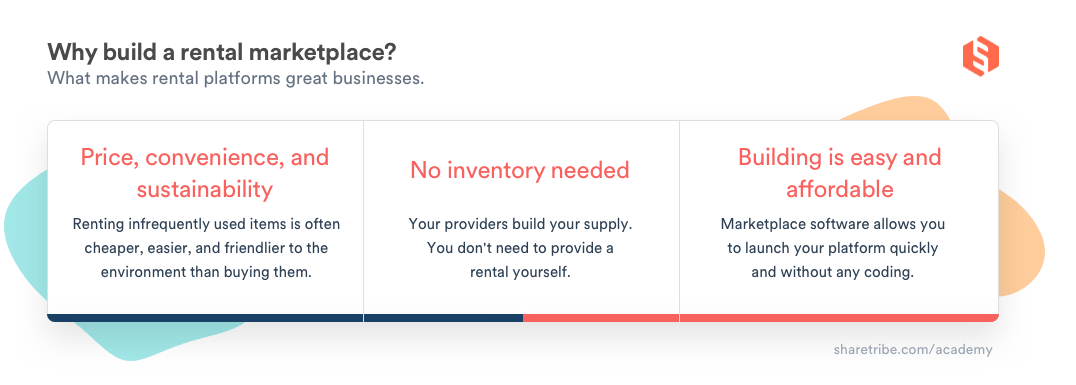
When you hear the word rent, many people immediately think of apartments or condos. But rental marketplaces cover a lot more ground than Airbnb and its competitors. In fact, the model has found its way into many different niches.
Here are nine areas where rental marketplaces are really popular:
- Accommodation. This is probably the most well-known niche for rental marketplaces. There's always a demand for temporary housing and vacation rentals, and these platforms have tapped into that need.
- Vehicles (cars, boats, RVs, bikes, etc.). Another big one is vehicles. Not everyone wants the hassle of owning a car or boat, so rental platforms make it easy to get around without the commitment of ownership. Peer-to-peer car rental, boat rental, and RV rental are popular marketplace concepts.
- Venues and locations. Party venue marketplaces are a popular concept. Thriving niche marketplaces have also been established around the rental of swimming pools, private land for outdoor experiences, film locations, music studios, and rehearsal spaces – you name it.
- Construction equipment. Construction equipment is expensive, and in some places, construction work is seasonal. That's why renting equipment instead of buying it outright is a smart move, and rental platforms are capitalizing on this.
- Fashion. Looking stylish can be expensive, but rental marketplaces offer a solution. You can rent high-end clothing and accessories for a special occasion without breaking the bank.
- Outdoor gear. Outdoor gear can be pricey, so, renting gear makes a lot of sense. Rental marketplaces have a strong presence in this niche.
- Luxury goods. Most people can't afford luxury items, but they still want to experience them. Rental marketplaces make it possible to enjoy luxury goods without the hefty price tag.
- Office space and equipment. Like accommodation, renting office space is a popular option. Co-working spaces, in particular, have seen a surge in popularity. Additionally, there's a demand for renting office equipment.
- Electronics and home appliances. Electronics and appliances are essential in modern life. When something breaks unexpectedly, rental marketplaces offer a quick and convenient solution.
- Community-based sharing platforms. There are lots of small and medium-sized platforms, and even a few big players, that offer a rental marketplace for “anything.”Usually, these platforms are heavily focused on local communities. These marketplaces let folks rent anything from lawnmowers to schoolbooks from each other.
It's interesting to see that all these niches have something in common: expensive ownership costs, on the one hand, and temporary need for these assets, on the other. Thus, with rental marketplaces, you can solve problems for both the providers and the customers and create viable platform businesses.
Many rental marketplaces have found great success, some even reaching billion-dollar valuations. Let's take a look at a few examples.
Airbnb is the archetypical peer-to-peer rental marketplace, symbolizing both what such marketplaces should look like and the business potential they hold.
Airbnb offers a revolutionary alternative to traditional hotels. It provided travelers with unique and often more affordable lodging options, catering to a growing desire for authentic experiences and local immersion.
On the other side of the marketplace, it offered hosts the opportunity to monetize their spare rooms and accommodations.
This dynamic supply and demand curve helped Airbnb become a billion-dollar brand and more valuable than the top 5 hotel chains combined!
A growing competitor of Airbnb’s is VRBO. The company was originally known as “Vacation Rental By Owner”, and this continues to be i its focus: offering a platform for owners to rent their homes, and for customers to find a suitable vacation rental for a family or group.
In the wake of Airbnb's success, clever founders have found more niches in the apartment rental market that are worth focusing on. For example, Sharetribe customer Scouter focuses on property rental specifically for the creative industry's shooting location needs.
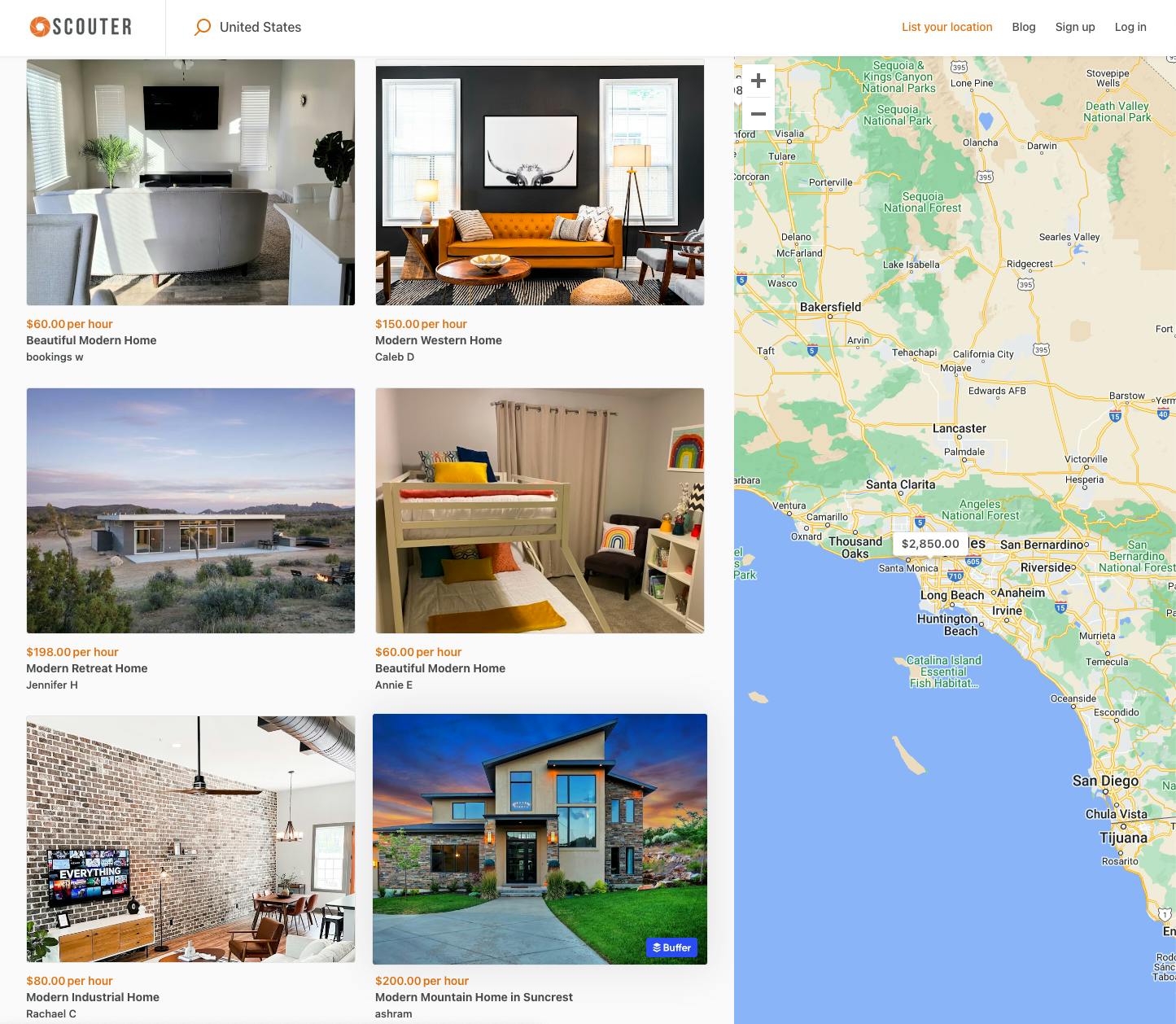
In addition to apartments, many other types of spaces and venues are needed on a temporary basis. This makes for an excellent rental marketplace concept.
Peerspace, for example, is the largest online marketplace for booking spaces for meetings, events, filmings, and photoshoots in cities across the United States. Listings include a wide variety of venues, from professional conference rooms and studios to unique and creative spaces like rooftops and galleries. Owning and maintaining these spaces is expensive, and the need is temporary, so a marketplace creates a win-win situation for both the space owners and the customers.
LiquidSpace connects individuals and businesses looking for workspace with venue owners who have spare office space: coworking spaces, meeting rooms, or private offices. It offers flexible contracts with immediate access and no commitment, which helps businesses of all sizes be more agile. At the same time, venue owners get to maximize the usage of valuable office space.
Mushroom is a Sharetribe-powered marketplace for a very specific niche: music rehearsal spaces. This is a fantastic idea: existing, large-scale space rental marketplaces don't address this specific need well, so a dedicated platform is well-positioned to compete and offer value for both the space owners and musicians in need of temporary rehearsal space.

A multitude of Sharetribe customers are thriving in the peer-to-peer rental of different types of outdoor and recreational spaces.
Swimmy is a game-changer for pool lovers. For renters, Swimmy offers a wide range of pool options to choose from, whether you're looking for a relaxing afternoon or a fun pool party. It's a win-win situation, where pool owners can earn extra income, and renters can enjoy a pool experience without the commitment of ownership. Here's the story on how Swimmy's founder Raphaëlle went from idea to thousands of users and millions of bookings.
Nomady is a successful marketplace that lets people book private campsites in some of Europe's most beautiful destinations. The platform gained traction at the peak of the pandemic without any marketing efforts.
LandTrust, another successful Sharetribe customer, connects private landowners with hunters and other outdoor enthusiasts. Since validating the idea, the marketplace has raised $6 million in Series A funding, employed 17 people, and made over one million acres of land available for users to explore through the LandTrust platform.
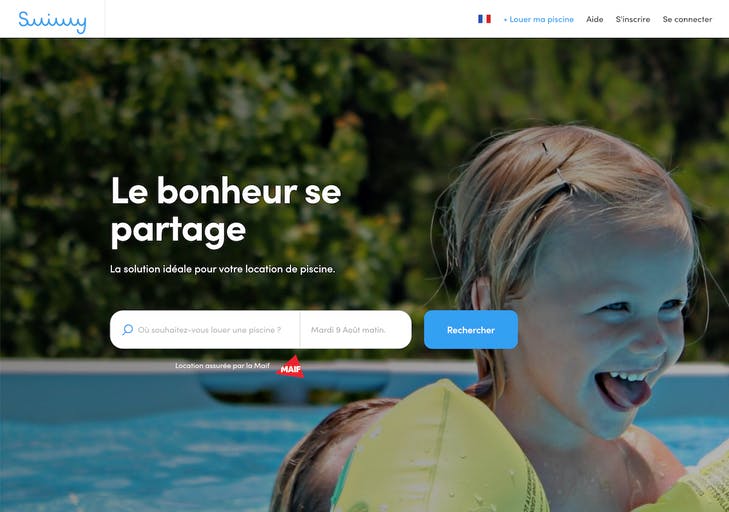
Cars are expensive to buy and own. Car rental marketplaces give folks without cars flexible access to a vehicle when needed, and help car owners cover costs by renting their cars rather than letting them sit idle in a parking lot.
Drive lah is a peer-to-peer car rental marketplace focused on the Singapore and Australia markets. It competes against big car rental marketplaces like Turo and Getaround by focusing on offering a localized experience with a strong emphasis on customer experience and trust.
For example, as co-founder Gaurav Singhal shared in our interview, before Drive lah, it was illegal in Singapore for private individuals to rent out their cars. The founders were able to work with the regulatory limits and establish a foothold in their market.
Drive lah’s marketplace is powered by Sharetribe. In this customer story on Drive lah, you can read how the founders went from an idea to a business with millions in funding and ambitious plans for growth.
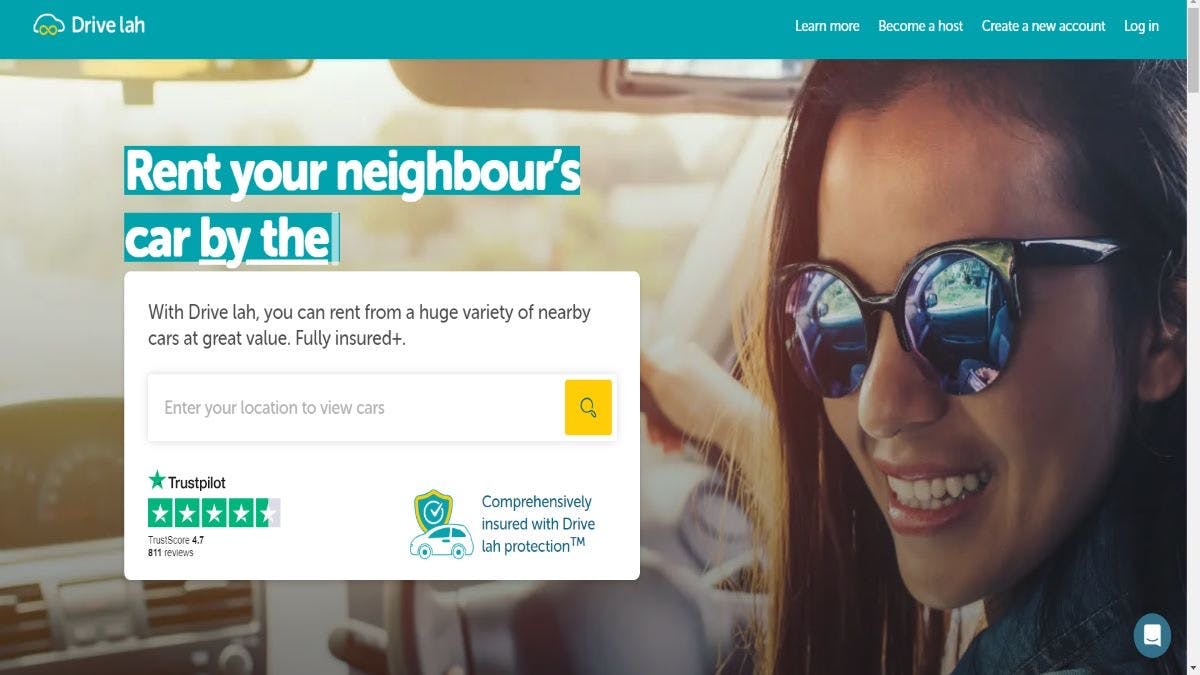
Cars aren’t the only vehicles that are expensive to own and sit idle most of the time. The same can be said about many vehicles: boats, RVs, bikes, and so on.
Outdoorsy and RVShare are well-known rental marketplaces focusing on RVs and campervans. GetMyBoat, Boatsetter and Sharetribe customer WetRentals allows boat owners to make their vessels available for rental when they are not in use.
Spinlister is a leading marketplace in the peer-to-peer rental of bikes, and Sharetribe customer Spokeo operates in the same niche, focusing on mountain, gravel, and road bikes. Sharetribe also powers an interesting niche marketplace called Side By Side Share, dedicated solely on the peer-to-peer rental of UTVs and ATVs.
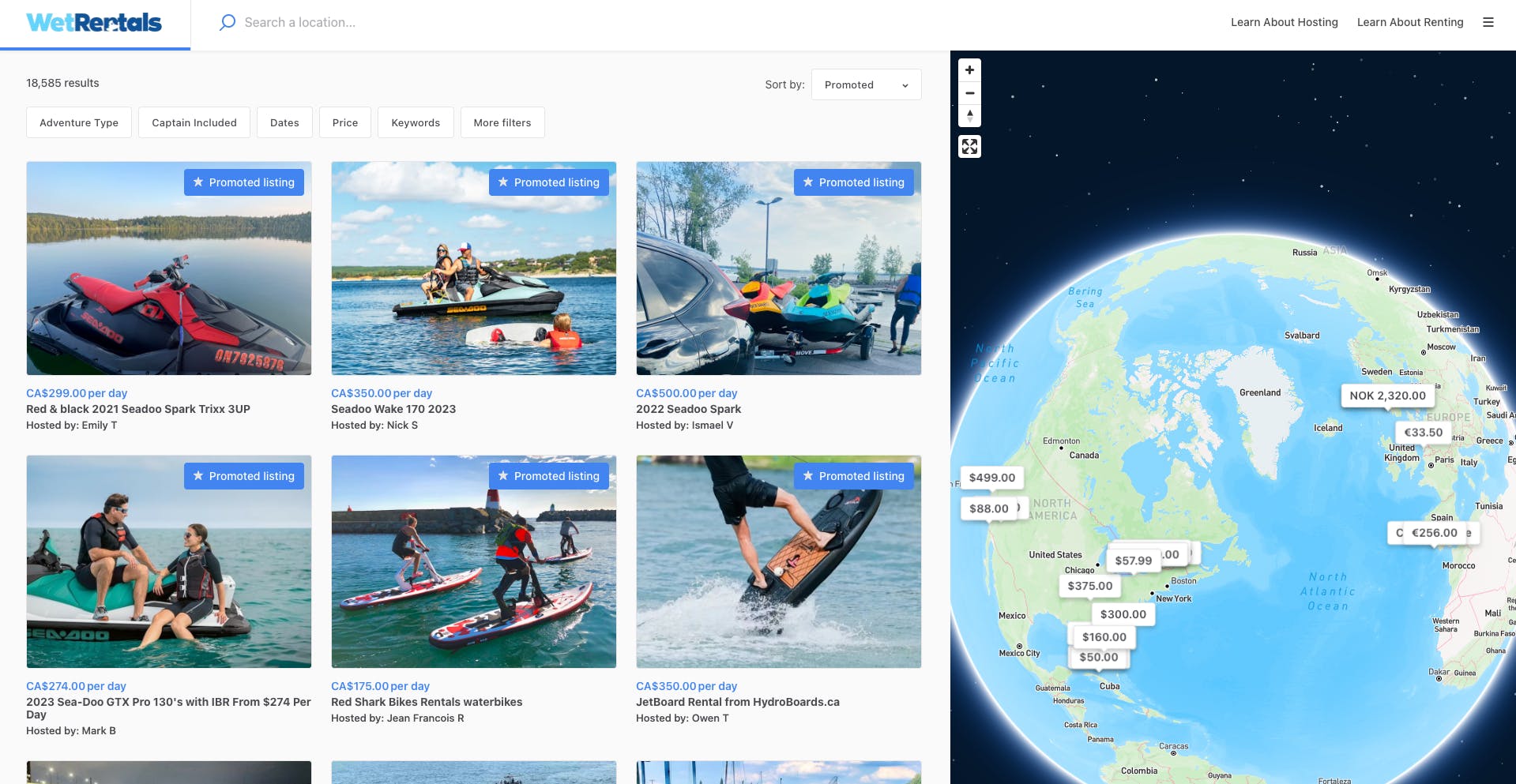
The largest equipment rental company in the US, BigRentz, is a B2B and B2C marketplace. It caters primarily to the needs of the construction industry but also serves other sectors and private individuals looking for construction and heavy equipment.
BigRentz’s rental inventory comes from different suppliers across multiple locations. This makes it easy for construction companies to find the equipment they need close to their job site, which helps them optimize logistics and reduce transportation costs. For rental owners, BigRentz offers a way to get maximum usage out of expensive construction equipment.
Sharetribe customer Eqpme is another great example of a marketplace that helps equipment owners to monetize idle machinery and existing equipment rental companies to get more eyes on their offering. The platform includes a wide selection of equipment categories.
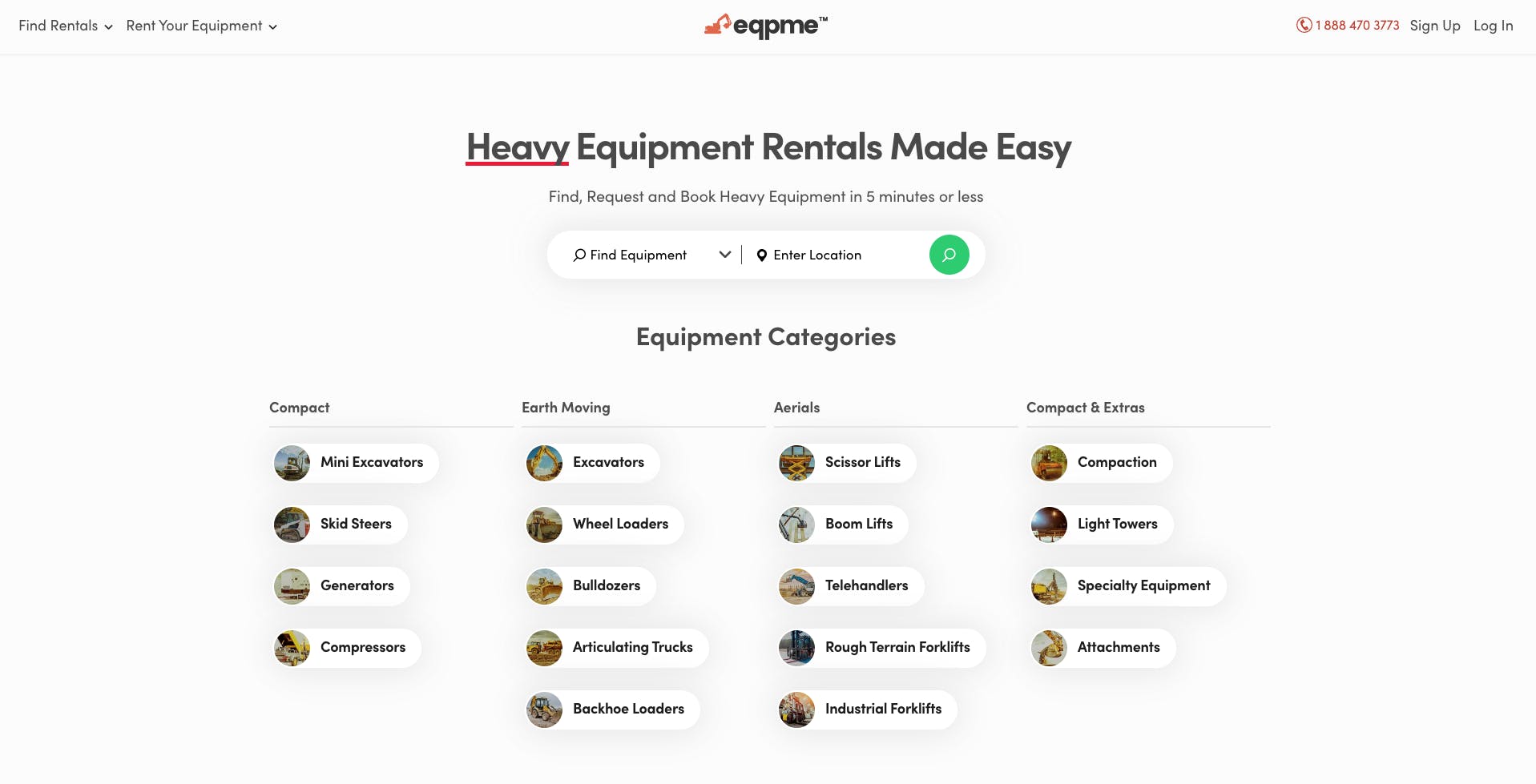
Some local marketplaces facilitate rentals across categories. These marketplaces often have a strong local focus and community element.
Peerby, for example, focuses on community-based sharing of everyday items. Whether it's a power tool, a ladder, or a party tent, Peeby makes it possible for people to access these items without having to buy them.
This model helps buyers save money and reduce waste and environmental impact associated with the production and disposal of goods. At the same time, the owners of these items get to earn a bit of money and maximize the use of their items.
Peerby currently operates in more than 5,000 Dutch cities. A similar marketplace concept is the Sharetribe-powered Rent Anything Store in the United States and Canada.
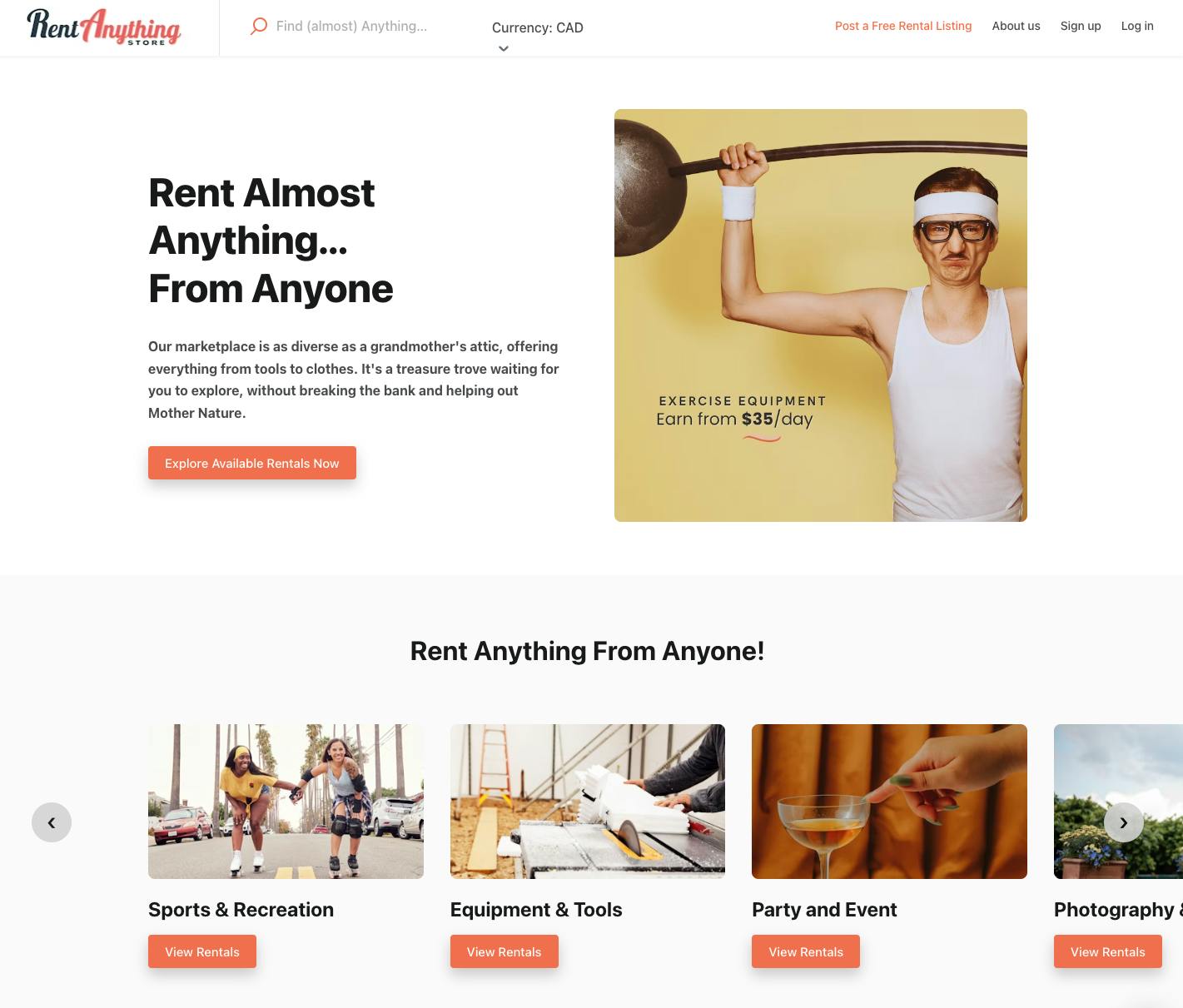
As you can see from all these examples, the possibilities for rental marketplace niches are as vast as your imagination.
Whether you're dreaming up a unique idea or looking for inspiration, Sharetribe has got you covered with its full range of rental marketplace features. Explore inspiring examples here.
In a nutshell, starting a rental marketplace requires these seven things:
- A great (pre-validated) marketplace idea.
- A sustainable business model.
- A list of essential rental feature requirements.
- A plan on how you're going to build your platform.
- A budget (depending on item 4., this could be anything from a few hundred dollars to $50,000+).
- A plan to acquire your first users.
- A plan to grow your marketplace.
Let's go through these requirements in more detail.
Every successful marketplace starts with an idea. In the case of Airbnb, it was the idea of renting spare rooms out to people in exchange for money. At that time, the founders of Airbnb, Brian Chesky and Joe Gebbia, were struggling to pay their monthly bills. Thus, you need to find such pressing problems that your rental marketplace can potentially solve.
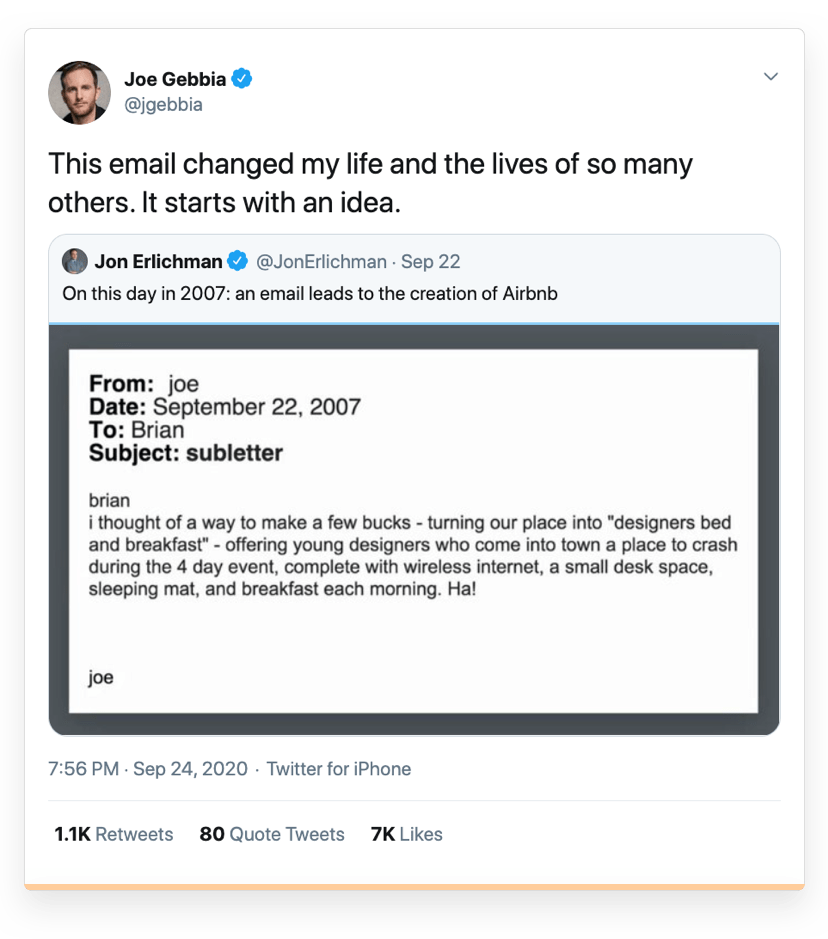
At Sharetribe, we've found that successful founders often land on their marketplace ideas through three different routes.
- They identify a problem they have themselves.
- They identify underused assets and inefficient buying processes or fragmented markets.
- They identify a niche market that’s poorly served on existing platforms.
We've also found that before getting to work, it helps if you can pre-validate your idea. Validation helps identify potential flaws or gaps in your initial concept. Addressing these issues early on saves you time, money, and effort that could be wasted on building a product nobody wants.
Online marketplaces for renting that succeed are backed by a suitable business model. Getting the business model right is key since a particular model working in a specific niche may not work for another.
In general, rental marketplaces tend to follow one of two marketplace business models:
1. Commission per transaction
2. Subscription
In the former case, users pay only when they use the service, with the marketplace taking a cut. The commission rate can vary anywhere from 5% to 50%. The thing to get right is whether to charge the buyer side, the seller side, or both.
In a subscription model, users pay a certain amount every month to get access to the services. This creates a continuous flow of income for the marketplace. But it's not suited for users who rent items once in a while.
The beauty of the commission model is that it doesn’t create a barrier for sellers or buyers. They only pay something for the platform when they’ve received value (made a sale or found what they are looking for).
At the same time, commission can be a very lucrative and scalable business model: you get a piece of all the value that passes through your platform. That’s why most successful marketplaces monetize through commission.
It’s also possible for marketplaces to monetize with a combination of subscription and commission. Some marketplaces have additional revenue streams through services (like insurance or shipping) or featured listings and ads.
A rental marketplace can have an endless list of features. If you’re benchmarking giants like Airbnb or Turo, it’s easy to think you need to offer the exact same experience.
But when you're just starting, you can't build everything at once. Instead, you need to pick the ones that:
- Let you solve a key problem for your providers and customers.
- Solve that problem better than any other existing solution.
This is in line with the MVP or Minimum Viable Product principle, which states that your first product should have a very limited set of features. This way, you get to launch fast and see if your idea has wings.
The features you select should be in line with your scope. As a general rule, it’s always best to start with a very limited focus. By narrowing down, you can serve a particular group of customers, understand their needs, and gain expertise.
Here's a rundown of the key features every successful rental marketplace needs:
- User profiles: When users, both providers and renters, join your platform, they create profiles with their name, photo, and other relevant info.
- Listings: Providers can showcase their items with images and descriptions so renters know what they're getting.
- Map & location: Since rentals are often location-based (think bikes, cars, or homes), having a map feature is crucial for users to find what they need nearby.
- Online payments: To make transactions smooth, your platform should offer secure payment options like credit cards or PayPal.
- Reviews: Building trust is essential. Both providers and renters should be able to leave reviews after a transaction to help others feel confident about their choices.
- Availability & booking management: Providers should be able to set their availability, and renters should easily see when items are free to rent.
- Holding funds & delaying payouts: Delaying payment until after the rental is complete helps ensure both parties uphold their end of the deal.
- Admin tools: You'll need tools to keep track of user activity, moderate content, and manage payments to ensure everything runs smoothly.
Even this limited set of essential features is time-consuming to code from scratch. In most cases, you get your idea out into the world a lot faster and more affordably with no-code tools.
Sharetribe, for example, has all the essential rental marketplace features listed above (and a lot more) available out of the box. Sharetribe is also infinitely extendable through code, so you can easily add more functionality as your business expands.
Next, you need the right tools and workforce to build the rental marketplace.
There are as many as six ways to build a marketplace:
1. Code it from scratch (or hire someone to do it).
2. Build on open-source marketplace software (self-hosted).
3. Use a generic website or e-commerce builder (like WordPress) with marketplace plugins, themes, or extensions.
4. Combine several no-code tools (e.g., Webflow, Airtable, and Zapier) or use a visual programming tool like Bubble.
5. Use a dedicated no-code marketplace software solution like Sharetribe.
6. Develop on top of an API-based marketplace solution (like Sharetribe’s Developer Platform).
During the dot-com boom and the years prior, the only option was to code the platform from scratch. This granted full flexibility in terms of functionality and the visual aspect. But building from scratch is extremely time-consuming, and, if outsourced, typically requires a budget north of $50,000.
Today, you have lots of no-code alteranatives to choose from. If you enjoy building, you can achieve the necessary marketplace functionality with a combination of plugins or no-code tools.
However, a dedicated marketplace like Sharetribe is likely the fastest and easiest choice. It also requires much less maintenance work than monitoring the interplay of several different products and is infinitely more scalable thanks to the Sharetribe Developer Platform.
Building a rental marketplace can be costly and time-consuming if you're starting from scratch. Developers typically charge around $50,000 for basic features, not including hosting, third-party tools, maintenance, and updates.
However, Sharetribe allows you to build a marketplace without any coding. Sharetribe's hosted, no-code builder lets you launch quickly and affordably. Plans start at $29/month, making it a cost-effective option for early-stage marketplace founders.
If you're looking to validate your idea and build an MVP, Sharetribe's 12-month Pro plan costs $249 per month (or $199 if you buy an annual subscription). If we look at the total costs for the first year of running your marketplace, it might look something like this:
- Sharetribe Pro plan for 12 months (annual billing): $2,388
- Domain registration for 12 months: $10
- Logo design – free using a tool like Canva: $0
- Stock images – free using a service like Unsplash: $0
- Blog and content marketing (Sharetribe's Pages feature): $0
- MailChimp email marketing – free up to 500 contacts: $0
- Google Analytics – free version: $0
Compared to building a marketplace from scratch, you'll save tens of thousands of dollars—and probably at least as many hours. That's time and money you can spend on building and growing your business instead. You can start your free Sharetribe trial here.
A rental marketplace brings together providers (the folks who list their items for rent) and customers (people looking for these items for rent). So, your next objective is to acquire both segments of users. But it's easier said than done.
Any marketplace faces the classic "Chicken-and-egg" problem. Do you go after the providers first or the customers? While there's no single answer, it's usually providers who have more to gain financially. Thus, it might be a good idea to go after the owners first.
In the case of Drive lah, the founders first contacted car owners inquiring whether they'd rent out their cars (owning a car is quite expensive in Singapore). Then, they went after the renters and built the marketplace. Likewise, Swimmy targeted pool owners first.
So, figure out which segment gains the most from the transaction and target them. This will make it easier to target the other side.
To build a profitable online marketplace for renting, you need to solve problems at scale. Thus, as a final step, you need to focus on scalability.
But before you scale, it's necessary that you hit:
- Problem-solution fit
- Product-market fit
Problem-solution fit is when your marketplace truly solves a problem that users are willing to pay for. Problem/solution fit is a stage where you:
- consistently facilitate transactions between supply and demand and
- collect revenue from those transactions.
This point is difficult to reach and can require you to adjust your positioning, messaging, product, or pricing. Don’t lose faith! And don’t strive for ambitious growth before validating your Problem-solution fit and reaching Product-market fit.
Product-market fit means you have identified a sizeable market where your marketplace can succeed. At this stage, you’ll improve on your initial MVP, establish a growth engine, and prove your business can become profitable.
Once you’ve reached Product-market fit in your initial niche, you have a great playbook for growth. Use the lessons you learned and grow your marketplace gradually by introducing new markets or rental categories and reaching Product-market fit in them one at a time.
As we saw, there are six ways to build a rental marketplace. But there's one method that enables you to launch your marketplace within a day. That is by using Sharetribe.
Sharetribe is a no-code marketplace builder for building and launching marketplace websites. You can configure it for your idea and customize the look and feel without writing a line of code. Once you’ve reached problem-solution fit, you can start expanding on the no-code features by adding your custom-developed elements (with the help of a verified Sharetribe developer if needed.) Here's how you can build a rental marketplace within a day with Sharetribe:
- Create an account and sign up for a free trial. When you’re creating an account, you’re first asked a series of questions, and a marketplace website is generated for you based on your answers, with certain default configurations. It's possible for you to change all these configurations later.
- (Start by creating a test user and listing. We recommended that you try out Sharetribe with a test user. This allows you to simulate the purchasing and payment processes and see how Sharetribe lets your users transact. When you log in to Sharetribe for the first time, simply follow the instructions on the landing page that guide you through the steps.)
- Define your marketplace. Listings are descriptions of the products and services available in your marketplace. With Sharetribe, you can choose between multiple listing types and configure your listing fields and search filters.
- Set your commission. Your customers and providers can process payments through your marketplace, and you can charge your commission for each transaction. At this step, you set your commission rate and your minimum charge.
- Change the logo and branding. Set the main color of your marketplace and upload your logo, and favicon.
- Edit your landing page. Add your hero title, description, call to action, and hero image (you can get one for free on Unsplash or check out Stocksy for more upmarket, paid images). Edit the rest of the page by adjusting the default section, or removing them and creating your own. You can and should test different landing pages as your business grows!
- Edit the Terms of Service and Privacy pages. In line with regulatory compliance, it's recommended that you create a dedicated T&C page and a privacy page detailing the data collection process.
- Buy a domain (optional). You can use a custom domain for your marketplace. Buy the domain and hosting from a domain hosting provider like GoDaddy, Hover, or Google Domains. Our support team will help you connect your domain to your marketplace.
- Set up your live marketplace environment. At this point, you’ll need a paid Sharetribe plan to start processing payments. Once you’ve selected a plan, our support team will help you connect Mapbox or Google Maps as your location service provider, your Stripe account, your custom domain, and your custom outgoing email address.
- Go live! 🎉🎉 Your marketplace is now ready to be launched to real users. The sky is the limit!
- Rental marketplaces are specific online platforms that facilitate rentals of goods and services for a specific period of time.
- There are as many as six ways to build a rental marketplace.
- The most trivial approach is to hire developers and code the platform from scratch. The latest and easiest approach is to use no-code platforms to set up the marketplace with little to no coding effort.
- Sharetribe enables anyone with no coding experience to set up a marketplace from scratch within a day.
Start your 14-day free trial
Let's build a rental marketplace
- Launch quickly, without coding
- Extend infinitely
- Scale to any size
No credit card required
